
In 2024, social media is as dynamic as ever, with some platforms dominating the conversation and others…well, let’s just say, they’ve fallen down the well. Whether you’re marketing to boomers, targeting Gen Z, or just curious about where your online hangouts rank, this is your nearly exhaustive guide to the major social media players in the U.S. today. From the giants to the niche apps, we break down their unique selling points, audience sizes, and what’s keeping (or killing) them in the game.

1. Facebook (Meta)
- U.S. Audience Size (2024): ~180 million
- Founded: 2004
Positioning: The place where your mom tags you in embarrassing childhood photos and local groups thrive. Facebook remains a massive hub for personal connections, community groups, and for marketers, the holy grail of targeted advertising.
Core Audience & Popularity:
- Core Age Group: 30-49 (Boomers and Gen X also call it home)
- Popularity: Still huge, but not exactly the first stop for Gen Z
- Why It Stays Relevant: Business pages, marketplace, groups
- Sass: Basically the ‘Yellow Pages’ of social media.

2. Instagram
- U.S. Audience Size (2024): ~170 million
- Founded: 2010
- Acquired by: Meta (2012)
Positioning: The aesthetic wonderland for photo and video content. If you’re looking for influencers, glossy travel shots, and fashion reels, this is where you’ll find them.
Core Audience & Popularity:
- Core Age Group: 18-34, especially heavy with millennials and older Gen Z
- Popularity: Highly engaged with visual creators, and still growing thanks to Reels (which, let’s be real, are borrowed from TikTok)
- Why It Stays Relevant: Influencers, brands, and your cousin’s brunch pics
- Sass: Because we needed another place to copy TikTok.

3. Snapchat
- Founded: 2011
- U.S. Audience Size (2024): ~85 million
Positioning: Ephemeral content king. Snapchat thrives on disappearing messages, face filters, and its weird UI that no one fully understands.
Core Audience & Popularity:
- Core Age Group: 13-24 (but hey, millennials still lurk here too)
- Popularity: High with teens, but kind of stagnating with everyone else
- Why It Stays Relevant: Private messaging, augmented reality filters
- Sass: Half the features are now on Instagram—ouch.

4. TikTok
- Founded: 2016
- U.S. Audience Size (2024): ~150 million
Positioning: The short-form video overlord, TikTok’s all about viral dances, chaotic trends, and rabbit holes of niche content you never knew you wanted {cough ~booktok~ cough}.
Core Audience & Popularity:
- Core Age Group: 13-34, dominates with Gen Z
- Popularity: Skyrocketed thanks to its addictive algorithm and user-generated content
- Why It Stays Relevant: Constant innovation, ultra-engaged audience
- Sass: We all said we hated vertical video. TikTok proved us wrong.

5. X (formerly Twitter)
- Founded: 2006
- Acquired by: Elon Musk (2022)
- U.S. Audience Size (2024): ~64 million
Positioning: The artist formerly known as Twitter—now X—remains a battleground of memes, news, and Musk-related chaos. It’s the platform for hot takes, trending hashtags, and oversharing.
Core Audience & Popularity:
- Core Age Group: 18-49, more male-dominated
- Popularity: Fading fast with the general public, but still a go-to for real-time events and “discussions” (read: arguments)
- Why It Stays Relevant: News junkies, meme lords, journalists
- Sass: The only thing more confusing than Twitter’s rebrand is Musk’s next move.

6. Threads
- Founded: 2023
- U.S. Audience Size (2024): ~60 million (but already dropping)
Positioning: Meta’s rushed attempt at creating a Twitter clone, Threads arrived with a bang, then fizzled out as people realized…wait, why are we here again? Threads is a space for text-based conversations with a hint of photo sharing.
Core Audience & Popularity:
- Core Age Group: 18-34, early adopters who quickly moved on
- Popularity: It had its 15 minutes of fame
- Why It Stays Relevant: Meta’s sheer force of will. Meta is trying its hardest, but…it’s fading
- Sass: They forgot to include a search function when they rolled it out, enough said.

7. Pinterest
- Founded: 2010
- U.S. Audience Size (2024): ~90 million
Positioning: The mood board of the internet. Whether you’re looking for DIY crafts, recipes, or how to redecorate your living room, Pinterest has it.
Core Audience & Popularity:
- Core Age Group: 25-44, especially strong with women
- Popularity: Highly engaged niche for home decor, lifestyle, and design
- Why It Stays Relevant: Visual search, shopping integration
- Sass: Basically Instagram for people who still believe in vision boards.

8. LinkedIn
- Founded: 2003
- Acquired by: Microsoft (2016)
- U.S. Audience Size (2024): ~200 million
Positioning: The professional social network, LinkedIn is where your college professor, that guy you met at a conference, and your future boss hang out.
Core Audience & Popularity:
- Core Age Group: 25-54, leaning toward professionals and execs
- Popularity: Massive for B2B, career networking, and thought leadership
- Why It Stays Relevant: Jobs, professional clout, endless humblebrag posts
- Sass: Just a fancy, work-friendly version of Facebook, but with worse memes.

9. Reddit
- Founded: 2005
- U.S. Audience Size (2024): ~55 million
Positioning: The front page of the internet, Reddit is where real nerds go for hyper-specific discussions, AMA (Ask Me Anything) sessions, and meme magic.
Core Audience & Popularity:
- Core Age Group: 18-34, more male-dominated
- Popularity: Massive in niche communities, less so with mainstream audiences
- Why It Stays Relevant: Anonymous discussions, subreddits on literally everything
- Sass: It’s the “dark web” of social media—minus the dark web.

10. YouTube
- Founded: 2005
- Acquired by: Google (2006)
- U.S. Audience Size (2024): ~230 million
Positioning: The king of video content, from tutorials to full-blown documentaries. Everyone’s here—from streamers to your uncle who just uploaded a cat video.
Core Audience & Popularity:
- Core Age Group: All ages, but especially dominant with 18-49
- Popularity: Still unbeatable as the home of all things video
- Why It Stays Relevant: Educational content, gaming, and endless entertainment
- Sass: You’ll fall into a rabbit hole, and you’ll never come out.

11. TikTok’s “Lemon8”
- Founded: 2020
- U.S. Audience Size (2024): ~20 million
Positioning: The lifestyle offshoot of TikTok, Lemon8 combines Instagram’s visual appeal with Pinterest-style discoverability, targeting the aesthetically inclined.
Core Audience & Popularity:
- Core Age Group: 18-29, heavy on creatives and lifestyle influencers
- Popularity: A niche hit that’s slowly growing, especially among content creators
- Why It Stays Relevant: Unique blend of visual storytelling and inspiration
- Sass: It’s what happens when Instagram and Pinterest had a millennial baby.

12. Tumblr
- Founded: 2007
- Acquired by: Automattic (2019)
- U.S. Audience Size (2024): ~15 million
Positioning: The original home for fandoms and aesthetic blogging. Tumblr is a mashup of long-form content, GIFs, and moody aesthetic boards. If you’re looking for a resurgence of chaotic creativity, this is where you go.
Core Audience & Popularity:
- Core Age Group: 18-29, leaning toward younger millennials
- Popularity: Declined significantly post-2013, but still home to niche communities and fandoms
- Why It Stays Relevant: Creative freedom, zero algorithm interference
- Sass: *The platform where fan fiction still thrives and Gen Z goes to feel “vintage.”

13. Clubhouse
- Founded: 2020
- U.S. Audience Size (2024): ~5-10 million (and dropping)
Positioning: The audio chatroom trendsetter. Clubhouse launched the live audio trend, but its shine has worn off as competitors like Twitter Spaces and Spotify Live jumped in.
Core Audience & Popularity:
- Core Age Group: 24-45, mostly entrepreneurs and early adopters
- Popularity: Peaked in 2021, but struggles to keep users engaged today
- Why It Stays Relevant: Niche discussions, networking, and real-time engagement
- Sass: The app that convinced everyone they needed to start a podcast…until they didn’t.

14. Twitch
- Founded: 2011
- Acquired by: Amazon (2014)
- U.S. Audience Size (2024): ~50 million
Positioning: The gaming livestream behemoth. Twitch dominates the gaming scene, but its reach extends to live creative streams, Q&As, and more.
Core Audience & Popularity:
- Core Age Group: 18-34, gamers and esports fans
- Popularity: Huge among the gaming community but niche outside of it
- Why It Stays Relevant: Real-time interaction with streamers, esports dominance
- Sass: If you don’t play video games, good luck understanding why anyone watches it.

15. BeReal
- Founded: 2020
- U.S. Audience Size (2024): ~10 million
Positioning: The anti-Instagram. BeReal wants you to capture life in all its messy, unfiltered glory by sharing real-time moments without curation.
Core Audience & Popularity:
- Core Age Group: 16-25, especially popular among Gen Z
- Popularity: A novelty app that caught fire in 2022 but is struggling to retain daily active users
- Why It Stays Relevant: Authenticity in a world of filters
- Sass: Trying to convince people to be real is harder than it sounds.

16. WhatsApp
- Founded: 2009
- Acquired by: Meta (2014)
- U.S. Audience Size (2024): ~90 million
Positioning: The messaging app of choice for privacy-conscious users who want free global text, voice, and video communication.
Core Audience & Popularity:
- Core Age Group: 25-49, especially strong with international users
- Popularity: Massive globally, less dominant in the U.S. compared to iMessage and Messenger
- Why It Stays Relevant: End-to-end encryption, international reach
- Sass: The app everyone in Europe and South America uses, but your U.S. friends ignore.

17. Discord
- Founded: 2015
- U.S. Audience Size (2024): ~56 million
Positioning: The ultimate voice and text chat platform for gamers that has evolved into a go-to for all types of communities—from gaming to studying to podcast fan groups.
Core Audience & Popularity:
- Core Age Group: 16-34, gamers and niche hobbyists
- Popularity: Growing rapidly with new use cases beyond gaming
- Why It Stays Relevant: Real-time chat, highly engaged communities
- Sass: Imagine a forum, but louder and more chaotic.

18. Nextdoor
- Founded: 2008
- U.S. Audience Size (2024): ~20 million
Positioning: The neighborhood gossip hub. Nextdoor connects people with their local community for everything from lost pets to petty complaints about neighbors.
Core Audience & Popularity:
- Core Age Group: 30-60, mostly homeowners
- Popularity: Highly engaged with local communities, but low global reach
- Why It Stays Relevant: Local recommendations, neighborhood connections
- Sass: The Facebook for nosy neighbors.

19. Rumble
- Founded: 2013
- U.S. Audience Size (2024): ~6 million
Positioning: A video-sharing platform often seen as an alternative to YouTube, with a focus on free speech and unfiltered content.
Core Audience & Popularity:
- Core Age Group: 25-49, more right-leaning audience
- Popularity: Growing, but still very niche compared to YouTube
- Why It Stays Relevant: Alternative content, less censorship
- Sass: For when YouTube is too “mainstream” for your tastes.

20. Mastodon
- U.S. Audience Size (2024): ~2 million
- Founded: 2016
Positioning: A decentralized social network that mimics Twitter’s timeline format but without corporate ownership or a single control point. Users join independent servers based on interests, and the entire platform operates in a federation model.
Core Audience & Popularity:
- Core Age Group: 25-45, tech-savvy users and open-source advocates
- Popularity: Gained traction during Twitter’s upheavals but remains niche
- Why It Stays Relevant: No ads, no algorithms, total freedom for users to curate their experience
- Sass: The social network for people who think they’re too smart for Twitter.
There you have it—20 social media platforms shaping the way we communicate, share, and consume content in 2024. From the giants to the surprisingly relevant, each of these platforms continues to influence the digital landscape in unique ways. Social media is constantly evolving, and with new platforms emerging, there’s always a fresh contender.
Do you think any of these platforms are on their way out, or are there others poised to take over? Share your thoughts—because one thing’s for sure, the digital landscape is always shifting!
[…] talk about location tracking. We’ve all seen the backlash against services like Facebook and Instagram over privacy concerns, and Gemini hasn’t escaped this conversation […]